Ask anyone who knows me: I didn't have much complaint with the mostly-screen, tightly-packed design of the original PlayStation Portable, first released three years ago. But time marches on, guys in labcoats and locked in cleanrooms are continually building better, smaller widgets, et voila, a 19%-slimmer, one-third-lighter PSP landed on my desk. As with the reduced-size PlayStation 2 a while back, there is no official name change, just a model number shift, to "PSP-2000."
The History of Cool
This is the second generation of the PSP hardware but the first time it has been covered on this site, and so a little perspective is in order. These days what makes a great portable gadget is not just the size but the multitasking, and of course how well it performs each of those tasks. Look at all the features that Apple keeps adding to the iPod, including a phone on their top-end handheld, while even the nano now plays video. They've added rudimentary, cellphone-quality games to certain models, and productivity tools to the touch via a purchased download. But first and foremost we're discussing entertainment devices here, so certainly a supply of worthwhile content--including Hollywood feature films--is also a key factor.
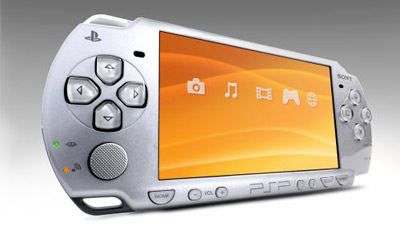
The all-in-one PlayStation Portable is the console, the controller, the screen, and the speakers, designed primarily to play games but also but also movies and music, as well as display digital photos. The 4.3-inch, 16:9 TFT LCD (at 480x272 pixels) display is gigantic by handheld standards. Its proprietary CPU decodes MPEG-4 H.264 and AVI video in addition to MP3, WAV, Windows Media Audio 9, ATRAC3, ATRAC3plus audio.
The $20-40 games and $10-and-up packaged movies arrive on Sony's Universal Media Disc (UMD), a small 1.8-gigabyte optical disc locked inside a plastic shell. Despite early studio support, UMD movies never became the next big thing, and even Sony Pictures eventually began offering some their films as digital files that could be stored on a Memory Stick PRO Duo card. Prices for MS PRO Duo cards have tumbled in recent years as a direct result of the popularity of the PSP, while capacities have skyrocketed. Eight Gigabyte (8 GB) Memory Sticks are available from both SanDisk and Sony. And Sony has recently released a Memory Stick with a whopping sixteen GigaBytes (16 GB) of storage - pretty impressive considering its tiny size. In addition to storing movies, a Memory Stick also allows us to store music, photos and game saves.
Although we would never condone copyright violation, many PSP owners I know are in the habit of "ripping" (copying/converting) their DVDs to smaller MPEG-4 files and dragging-and-dropping them from the computer to PSP via its USB 2.0 connection, once the proper folders have been set up. The 802.11b/g Wi-Fi-enabled PSP also scans for and connects to local networks to access the internet, link with other PSPs for wireless multiplayer gaming, or to a PlayStation 3 console to stream content. There's also a standard headphone mini-jack, but the original PSP offered no video out of any sort, and that was my only substantial gripe.
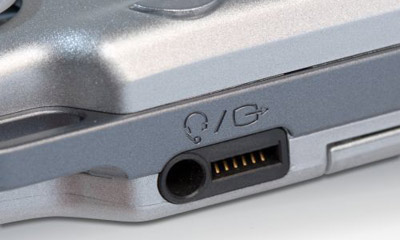
Whine and You Shall Receive
Chief among the enhancements to the PSP-2000 is, finally, a dedicated audio/video output which shares the familiar jacks for the headphone/remote control. Sony is selling optional two-and-a-half-meter composite and component video cables ($20 each) terminated in an A/V mini-plug that should be recognizable to anyone who has ever patched a portable DVD player into a TV.
Physical hookup of the cables to a television is child's play, and from there we navigate to the Connected Display Setting sub-menu to redirect the signal to the external display device. Or you can simply press and hold the Display button (below the screen, to the right of the PSP logo) for at least five seconds and it will automatically switch to video out. Press the button again when you want to switch back.
And now, ladies and gentlemen, for the first time, the PSP's so-called Xross Media Bar (sic) or "XMB" interface graces the large screen of the home theater! It's actually very similar to the PS3's version of the XMB interface, a left-to-right icon-based menu with up-and-down sub-menus to access all the content and features.
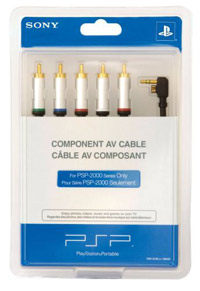
Interestingly, more of the XMB image was displayed on my Samsung HL-P5063W DLP HDTV than on the PSP screen, and yet movies were cropped slightly when viewed on the big TV. For games, Connected Display must be set to progressive scan, so your television must support 480p or better for large screen fragging. Owing to the maximum available 480-by-272 resolution of PSP games, they are displayed in a floating four-corner windowbox, surrounded by a fairly thick black border on all sides. You might therefore want to experiment with your TV's Zoom function, if it has one.
Those dismissing the need for a video out argued that PSP games were never intended for such large-scale exhibition and would not hold up on an HDTV screen. You might be pleasantly surprised at how good games look, in the ballpark of PlayStation 2 quality, with of course the stair-stepping and pixilation you'd expect, but enjoyable and certainly delivering enough detail in the lurking virtual enemies and the bending racetracks ahead to get the job done.
Reality Check
A friend mentioned that the maximum 1.8-gigabyte capacity of a UMD was a mere one-fifth that of a dual-layer DVD, implying that these pocketable movies would be nigh-unwatchable in the living room. What he forgot was that UMDs use the generally more efficient MPEG-4 file format--rapidly becoming the standard codec for high-definition DVRs--as opposed to the more unwieldy, less efficient MPEG-2 files you'd find on a DVD.
That being said, the picture quality when displayed up on a large screen--at up to 720-by-480--is actually not all that bad. Artifacting is evident in the usual places. Clouds and fine details show a bit of blockiness, the deliberate grain in the opening scenes of Casino Royale for example does not play well with this level of compression, but neither is it fatal. If you have access to a particular title only on UMD (I've noticed a lot of bargains at retail lately), video quality in the home theater will be on a par with first- or second-generation DVD.
Although video performance is not listed among the PSP's specific hardware improvements, in side-by-side tests with the same UMD playing on old and new models, the contrast appears to be superior on the Slim PSP, resulting in an overall brighter, often crisper image.
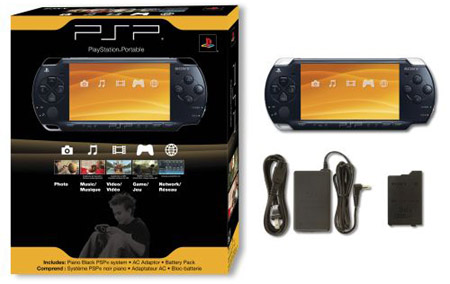
Resized, Relocated, Rethought
The original PSP felt good in the hands, definitely solid, with intuitive access to the recognizable triangle/circle/cross/square enter keys, up/down/right/left directional buttons, analog stick, the left/right shoulder buttons. The reduction in weight is dramatic to old-schoolers like me, and the symmetrical bulbousness of the left and right rear has now been flattened. The move to smooth instead of textured plastic also gives it a softer touch, while the buttons are more pronounced, especially the keys of the D-pad, with a bit more give too, for a more responsive experience.
Some of the new features are a bit more subtle but still welcome additions, such as the newfound freedom to charge the unit via USB while connected to either a PlayStation 3 console or a PC. That's conceivably one less adapter to pack when traveling, or we can opt for one of several third-party USB/AC adapters (the $30 Belkin Dual USB power adapter includes mini-USB and iPod cables), although a full charge via USB requires about twice as long as with the standard PSP AC adapter, which only takes about two hours.
Battery life is about the same four hours with the new 1,200 mAh power cell, which is smaller than the original, yet more efficient. Interestingly, the older, thicker 1,800 mAh battery will fit here, so you might have a spare on your hands now, but the new PSP's battery cover won't close over it. Sony has updated their $45 Extended Life Battery Kit with two custom covers to accommodate their double-duty 2,200 mAh power cell in the new PSP-2000.
The stereo speakers were formerly downward firing, along the bottom edge where they could easily be inadvertently muffled. Now they're front-firing near the top of the face for much better projection. The UMD door around back has been simplified in both good and bad ways: It's no longer spring-loaded, needing a fingernail to pull it open, but it extends wider, so we can drop in a disc more leisurely, rather than sliding it into the old tight metal bracket. The wireless LAN switch has been relocated from side to top, while the infrared receiver has been removed altogether, before I was ever able to figure out what it was there for, so I certainly don't miss it.
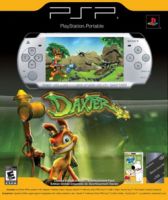
What You Don't See
Under the hood, the primary upgrade is in the RAM, now doubled to 64 megabytes. With "UMD Cache," this additional memory allows for faster loading of games, as the data from the optical disc can be more aggressively buffered for ready access. The actual improvement varies from game to game, although at least a few seconds were shaved from each of the titles I tried, averaging about a 20% decrease in load time. Movie loading times were brief, but no briefer than before.
I had encountered some frustration with the volume level of the original PlayStation Portable on airplanes, as the PSP can't quite compete with the cabin noise, and unfortunately the audio output has not been increased on this new unit. (Noise-canceling headphones and a Boostaroo Headphone Amplifier solve that problem.) It's still too easy to accidentally Power down when clicking out of Hold mode, but at least the shoulder buttons, which are very easy to bump, no longer bring unwanted chapter skips.
In addition to a standalone Piano Black model, an Ice Silver PSP is available as part of the Daxter Pack, with that not-so-new-but-excellent game, a repackaged "best of" Family Guy UMD video and a 1GB Memory Stick PRO Duo. A Ceramic White model is also available, with a sweet black Darth Vader silkscreen on the back, sold exclusively in the Star Wars Battlefront: Renegade Squadron bundle with the LucasArts game, a PSP-only title. There's even a Deep Red God of War Entertainment Pack set to arrive in June with a copy of the God of War: Chains of Olympus game, the movie Superbad on UMD, plus a free PlayStation Network download of Syphon Filter: Combat Ops.
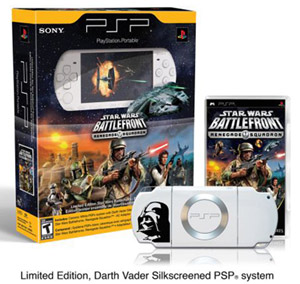
Believe the Skype
Continuous changes to the PSP firmware have also been taking place throughout the intervening years, unlocking everything from limited internet access (no keyboard) to inspired interactivity with the PS3. This Remote Play feature allows you to turn on your PS3 at home from anywhere, via the internet, and access its video, music and games on the PSP.
Perhaps in response to Apple's infamous push to add telecommunication to their flagship device, Sony has gone and shattered all previous notions of the PSP's versatility by retrofitting a phone into their handheld. Sort of: The Slim PSP can now Skype, adding the ability to make and receive "free" phone calls via the Internet. With the version 3.90 firmware installed and connected to a Wi-Fi hotspot, we can combine the PSP Headset with its attached microphone and the remote control which comes with the PSP-2000 Headphones (both optional accessories), and insert a Memory Stick Duo to save the Skype application. From the Network icon of the XMB we select the Skype/Sign In icon, then enter an existing username and password--one character at a time--or create a new account. From there we either choose a stored Contact or continue to the Dial function.
Is this an elegant phone solution? Does it work right out of the box? Is unrestricted wireless Internet access easy to find? No, no and no, but it really does work. We don't have to pay for the privilege if we don't want to, and I certainly wasn't expecting the ability to talk to people through my portable entertainer. But Sony has been pushing hard to continually enhance their robust-yet-Slim PSP with such imaginative firmware revisions, so as much as I admire the Slim PSP today, ask me in a few months and I'll probably like it even more.
Final Thoughts
The combination of design specs and available features really put the PSP in a class by itself. Making serious comparison to either the Nintendo DS as a gaming device or the iPod as a multimedia player would be a futile effort. With a gorgeous screen now even more so, video output, new bundles and a host of tweaks, Sony's pocket rocket is more of a blast than ever.
Where to Buy:
Manufacturer's Specifications
Manufacturer's Contact Information
Sony Computer Entertainment America
919 East Hillsdale Boulevard
2nd Floor
Foster City, CA 94404
ph: 800-345-SONY
website: www.us.playstation.com/psp
| Overall | |
|---|---|
| Value | |
| Performance | |
| Features/Ergonomics |